[1]
Y. Zhou, M. Eck, M. Kruger, Bulk-heterojunction hybrid solar cells based on colloidal nanocrystals and conjugated polymers, Energy & Environmental Science 3 (2010) 1851–1864.
DOI: 10.1039/c0ee00143k
Google Scholar
[2]
C.-H.M. Chuang, P.R. Brown, V. Bulović, M.G. Bawendi, Improved performance and stability in quantum dot solar cells through band alignment engineering, Nat Mater 13 (2014) 796–801.
DOI: 10.1038/nmat3984
Google Scholar
[3]
N.M. Gabor, Z. Zhong, K. Bosnick, J. Park, P.L. McEuen, Extremely Efficient Multiple Electron-Hole Pair Generation in Carbon Nanotube Photodiodes, Science 325 (2009) 1367–1371.
DOI: 10.1126/science.1176112
Google Scholar
[4]
R.A. Hatton, A.J. Miller, Silva, S. R. P., Carbon nanotubes: a multi-functional material for organic optoelectronics, Journal of Materials Chemistry 18 (2008) 1183–1192.
DOI: 10.1039/b713527k
Google Scholar
[5]
M. Jørgensen, K. Norrman, F.C. Krebs, Stability/degradation of polymer solar cells, Solar Energy Materials and Solar Cells 92 (2008) 686–714.
DOI: 10.1016/j.solmat.2008.01.005
Google Scholar
[6]
E. Kymakis, Amaratunga, G. A. J., Single-wall carbon nanotube/conjugated polymer photovoltaic devices, Applied Physics Letters 80 (2002) 112–114.
DOI: 10.1063/1.1428416
Google Scholar
[7]
A.J. Miller, R.A. Hatton, Silva, S. R. P., Water-soluble multiwall-carbon-nanotube-polythiophene composite for bilayer photovoltaics, Applied Physics Letters 89 (2006) 123115.
DOI: 10.1063/1.2356115
Google Scholar
[8]
T.M. Barnes, J.D. Bergeson, R.C. Tenent, B.A. Larsen, G. Teeter, K.M. Jones, J.L. Blackburn, van de Lagemaat, Jao, Carbon nanotube network electrodes enabling efficient organic solar cells without a hole transport layer, Applied Physics Letters 96 (2010).
DOI: 10.1063/1.3453445
Google Scholar
[9]
P.R. Somani, S.P. Somani, M. Umeno, Application of metal nanoparticles decorated carbon nanotubes in photovoltaics, Applied Physics Letters 93 (2008) 33151–33153.
DOI: 10.1063/1.2963470
Google Scholar
[10]
V. Georgakilas, D. Gournis, V. Tzitzios, L. Pasquato, D.M. Guldi, M. Prato, Decorating carbon nanotubes with metal or semiconductor nanoparticles, Journal of Materials Chemistry 17 (2007) 2679–2694.
DOI: 10.1039/b700857k
Google Scholar
[11]
F. Mammeri, A. Ballarin, M. Giraud, G. Brusatin, S. Ammar, Photoluminescent properties of new quantum dot nanoparticles/carbon nanotubes hybrid structures, Colloids and Surfaces A: Physicochemical and Engineering Aspects 439 (2013) 138–144.
DOI: 10.1016/j.colsurfa.2013.03.026
Google Scholar
[12]
D. Eder, Carbon Nanotube−Inorganic Hybrids, Chemical Reviews 110 (2010) 1348–1385.
DOI: 10.1021/cr800433k
Google Scholar
[13]
M. Eck, C. van Pham, S. Zufle, M. Neukom, M. Sessler, D. Scheunemann, E. Erdem, S. Weber, H. Borchert, B. Ruhstaller, M. Kruger, Improved efficiency of bulk heterojunction hybrid solar cells by utilizing CdSe quantum dot-graphene nanocomposites, Physical Chemistry Chemical Physics 16 (2014).
DOI: 10.1039/c4cp01566e
Google Scholar
[14]
C.V. Pham, M. Eck, M. Krueger, Thiol functionalized reduced graphene oxide as a base material for novel graphene-nanoparticle hybrid composites, Chemical Engineering Journal 231 (2013) 146–154.
DOI: 10.1016/j.cej.2013.07.007
Google Scholar
[15]
Y. Yuan, F.-S. Riehle, H. Gu, R. Thomann, G. Urban, M. Krüger, Critical Parameters for the Scale-Up Synthesis of Quantum Dots, Journal of Nanoscience and Nanotechnology 10 (2010) 6041–6045.
DOI: 10.1166/jnn.2010.2564
Google Scholar
[16]
J. Čech, S.A. Curran, D. Zhang, J.L. Dewald, A. Avadhanula, M. Kandadai, S. Roth, Functionalization of multi-walled carbon nanotubes: Direct proof of sidewall thiolation, physica status solidi (b) 243 (2006) 3221–3225.
DOI: 10.1002/pssb.200669102
Google Scholar
[17]
Y. Zhou, M. Eck, C. Veit, B. Zimmermann, F. Rauscher, P. Niyamakom, S. Yilmaz, I. Dumsch, S. Allard, U. Scherf, M. Krüger, Efficiency enhancement for bulk-heterojunction hybrid solar cells based on acid treated CdSe quantum dots and low bandgap polymer PCPDTBT, Solar Energy Materials and Solar Cells 95 (2011).
DOI: 10.1016/j.solmat.2010.12.041
Google Scholar
[18]
A.F. Madsuha, C. van Pham, R. Thomann, M. Krueger, Quantum dot-nanocarbon based hybrid solar cells with improved long-term performance, Synthetic Metals.
DOI: 10.1016/j.synthmet.2016.06.013
Google Scholar
[19]
S. Yoo, B. Domercq, B. Kippelen, Intensity-dependent equivalent circuit parameters of organic solar cells based on pentacene and C60, Journal of Applied Physics 97 (2005) 103706.
DOI: 10.1063/1.1895473
Google Scholar
[20]
Y. Shen, K. Li, N. Majumdar, J.C. Campbell, M.C. Gupta, Bulk and contact resistance in P3HT:PCBM heterojunction solar cells, Photovoltaics, Solar Energy Materials & Thin Films, IMRC 2009-Cancun 95 (2011) 2314–2317.
DOI: 10.1016/j.solmat.2011.03.046
Google Scholar
[21]
D. Zhang, D.Z.-R. Wang, R. Creswell, C. Lu, J. Liou, I.P. Herman, Passivation of CdSe Quantum Dots by Graphene and MoS2 Monolayer Encapsulation: Chemistry of Materials, Chem. Mater. 27 (2015) 5032–5039.
DOI: 10.1021/acs.chemmater.5b01522
Google Scholar


